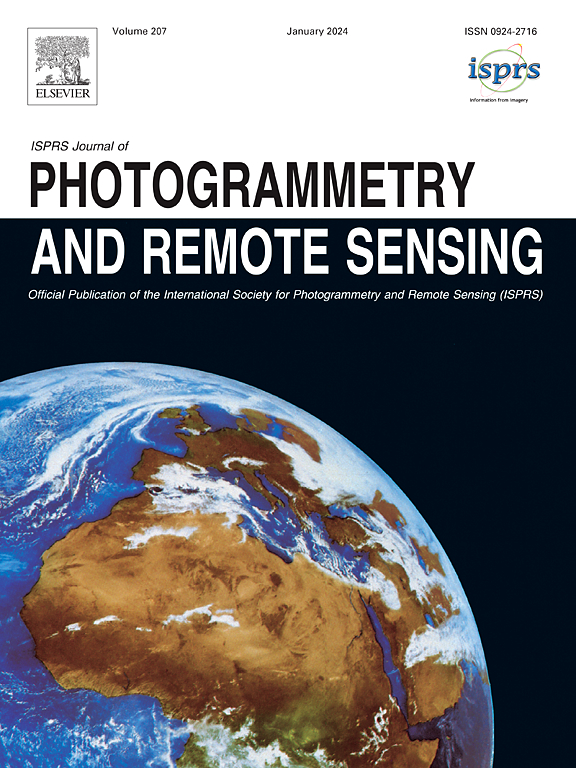Modeling the satellite instrument visibility range for detecting underwater targets
IF 10.6
1区 地球科学
Q1 GEOGRAPHY, PHYSICAL
ISPRS Journal of Photogrammetry and Remote Sensing
Pub Date : 2025-02-26
DOI:10.1016/j.isprsjprs.2025.02.013
引用次数: 0
Abstract
To assess the ability of a satellite instrument to detect submerged targets, we constructed a semi-analytical relationship to link target reflectance and the contrast threshold of the satellite instrument to visibility ranges. Using numerical simulation, we found that the contrast threshold of the satellite instrument was equal to 50 % of the residual error contained in satellite Rrs data. We evaluated our model using known sea depths of optically shallow water and found that the model produced ∼ 16 % uncertainty in retrieving the visibility range around the edge of the optically shallow water. By comparison, the contrast threshold of the human eye was more than 20 times larger than the satellite instrument contrast threshold. In addition, using a Secchi disk submerged in the shallow water, we found that the Secchi disk was invisible to the human eye when the disk was still visible to a high-quality camera handheld or mounted on an unmanned aerial vehicle. Moreover, when the image data quality was as well as MODIS instrument, we found that the maximum instrument visibility range reached 130 m in theory, which was approximately four times larger than the maximum reached by the human eye. Our findings suggest that high-quality cameras such as satellite instruments are more effective than the human eye for detecting underwater targets.
用于探测水下目标的卫星仪表可见范围建模
为了评估卫星仪器探测水下目标的能力,我们构建了一个半解析关系,将目标反射率和卫星仪器的对比度阈值与可见范围联系起来。通过数值模拟,我们发现卫星仪器的对比度阈值等于卫星rs数据中所含残差的50%。我们使用已知的光学浅水的海洋深度评估了我们的模型,发现该模型在检索光学浅水边缘周围的可见范围时产生了~ 16%的不确定性。通过对比,人眼的对比度阈值比卫星仪器的对比度阈值大20倍以上。此外,我们在浅水中使用塞奇磁盘,发现塞奇磁盘对人眼是不可见的,而手持或安装在无人机上的高质量相机仍然可以看到该磁盘。此外,当图像数据质量与MODIS仪器相同时,我们发现仪器的最大可见范围理论上达到130 m,大约是人眼所能达到的最大可见范围的4倍。我们的发现表明,像卫星仪器这样的高质量相机在探测水下目标方面比人眼更有效。
本文章由计算机程序翻译,如有差异,请以英文原文为准。
求助全文
约1分钟内获得全文
求助全文
来源期刊

ISPRS Journal of Photogrammetry and Remote Sensing
工程技术-成像科学与照相技术
CiteScore
21.00
自引率
6.30%
发文量
273
审稿时长
40 days
期刊介绍:
The ISPRS Journal of Photogrammetry and Remote Sensing (P&RS) serves as the official journal of the International Society for Photogrammetry and Remote Sensing (ISPRS). It acts as a platform for scientists and professionals worldwide who are involved in various disciplines that utilize photogrammetry, remote sensing, spatial information systems, computer vision, and related fields. The journal aims to facilitate communication and dissemination of advancements in these disciplines, while also acting as a comprehensive source of reference and archive.
P&RS endeavors to publish high-quality, peer-reviewed research papers that are preferably original and have not been published before. These papers can cover scientific/research, technological development, or application/practical aspects. Additionally, the journal welcomes papers that are based on presentations from ISPRS meetings, as long as they are considered significant contributions to the aforementioned fields.
In particular, P&RS encourages the submission of papers that are of broad scientific interest, showcase innovative applications (especially in emerging fields), have an interdisciplinary focus, discuss topics that have received limited attention in P&RS or related journals, or explore new directions in scientific or professional realms. It is preferred that theoretical papers include practical applications, while papers focusing on systems and applications should include a theoretical background.
 求助内容:
求助内容: 应助结果提醒方式:
应助结果提醒方式:


